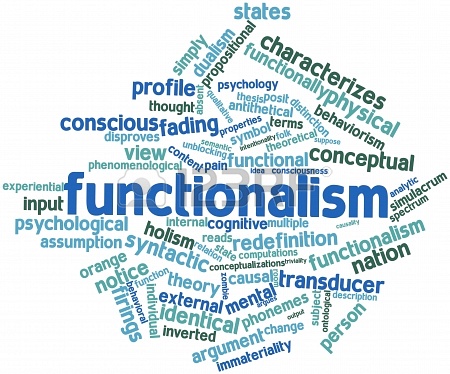MOVING BEYOND LIMITED EFFECTS: FOCUS ON FUNCTIONALISM AND CHILDREN Functionalism Theoretical approach that conceives of social systems as living organisms whose various parts work, or function, together to maintain essential processes Communication systems theory Theory that examines the mass communication process as composed of interrelated parts that work together to meet some goal Social cognitive theory Theory of learning through interaction with the environment that involves reciprocal causation of behavior, personal factors, and environmental events THEORIES OF THE MIDDLE RANGE AND THE FUNCTIONAL ANALYSIS APPROACH Merton (1967, p. 68) described middle-range theory as follows: Middle-range theories consist of limited sets of assumptions from which specific hypotheses are logically derived and confirmed by empirical investigation. These theories do not remain separate but are consolidated into wider networks of theory. These theories are sufficiently abstract to deal with differing spheres of social behavior and social structure, so that they transcend sheer description […]
THE RISE OF LIMITED-EFFECTS THEORY
THE RISE OF LIMITED-EFFECTS THEORY Two wars—one imaginary, one real—helped move mass communication theory away from notions of powerful and subversive mass media to a more moderate and benign view. The War of the Worlds researchers, led by Hadley Cantril, were part of a vanguard of social scientists who transformed our view of how media influence society. Within twenty years of Welles’s broadcast, the way many scholars looked at mass media had been radically altered. They no longer feared media as potential instruments of political oppression and manipulation, but instead portrayed mass communication as a relatively benign force with much potential for social good. Researchers gradually came to see media’s power over the public as limited—so limited that no government regulations were deemed necessary to prevent manipulation. limited-effects perspective The guiding idea that media have minimal or limited effects THE DEVELOPMENT OF LIMITED-EFFECTS THEORY The people who developed limited-effects theory […]
Unpacking Political News
Unpacking Political News The first portion of the chapter reviews the impact of journalistic routines on political news-gathering. The second part looks at the role played by organizational forces, a topic that brings us eyeball to eyeball with controversies involving Fox News. The third section explores the ways that an array of economic factors shape news. The final portion describes the complex ways that the larger political system influences news, particularly coverage of recent wars. MEDIA ROUTINES What are media routines? They are defined as “those patterned, routinized, repeated practices and forms that media workers use to do their jobs”. From a professional perspective, routines enable reporters to gain information efficiently, providing tried-and-true methods to determine which information should pass through the informational gates and which should be discarded. There are three key routines: (1) Ethically based and journalistic news values; (2) Reliance on sources; (3) Dependence on informational channels. […]
Literature Review or What is Review of literature?
Review of literature What is a review of literature? What steps must you take in preparing to write a literature review? Writing the introduction Writing the body Writing the conclusion What is a review of literature? The format of a review of literature may vary from discipline to discipline and from assignment to assignment. A review may be a self-contained unit — an end in itself — or a preface to and rationale for engaging in primary research. A review is a required part of grant and research proposals and often a chapter in theses and dissertations. Generally, the purpose of a review is to analyze critically a segment of a published body of knowledge through summary, classification, and comparison of prior research studies, reviews of literature, and theoretical articles. What steps must you take in preparing to write a literature review? There are a number of steps to undertake […]
Major Players of Satellites Communication
Major Players of Satellites Communication A communications satellite is an artificial satellite stationed in space for the purposes of telecommunications. Modern communications satellites use geosynchronous orbits, Molniya orbits or low Earth orbits. Geostationary orbits The geostationary orbit is useful for communications applications because ground based antennae, which must be directed toward the satellite, can operate effectively without the need for expensive equipment to track the satellite’s motion. Especially for applications that require a large number of ground antennae (such as direct TV distribution), the savings in ground equipment can more than justify the extra cost and onboard complexity of lifting a satellite into the relatively high geostationary orbit. The first geostationary communications satellite was Anik 1, a Canadian satellite launched in 1972. The United States launched their own geostationary communication satellites afterward, with Western Union launching their Westar 1 satellite in 1974, and RCA Americom (later GE Americom, now SES […]
Communication & International Communication
Communication & International Communication 1. What is Communication? • The word communication has originated from a Latin word “Communes” which means something common. • Communication is a process of exchanging information, ideas, thoughts, feeling and emotions through speech signals, writing or behavior. • In communication process, a sender encodes a message and then using a medium and send it to appropriate feedback using a medium 3. Importance of Communication • Express thoughts, ideas and feelings • Creating awareness • To fulfill a goal • Highlight issues • Progress, development • Educating the masses etc. 4. Process of Communication 5. Types of Communication • People communicate with each other in a number of ways that depend upon the message and its context in which it is being sent. • Types of communication based on the communication channels used are – • Verbal Communication • Nonverbal Communication 6. Nonverbal Communication • Nonverbal […]
